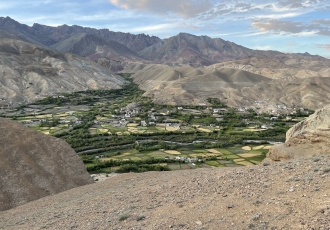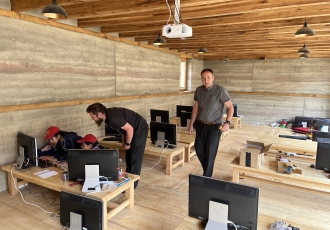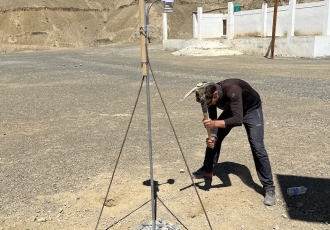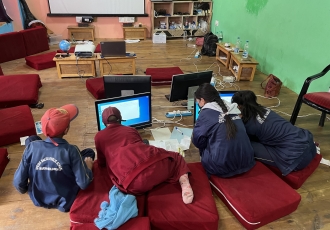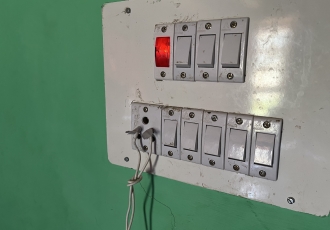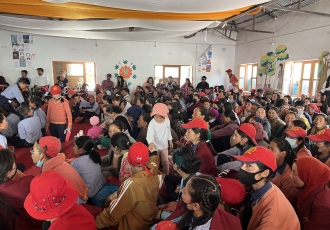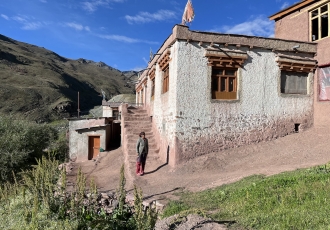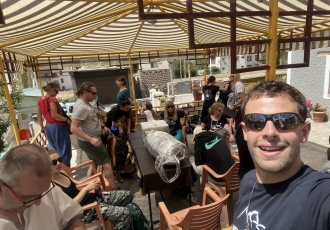5. Sept. 2022
He switched off the news from Europe for a month and went to help as a volunteer for Brontosaurus in the Himalayas in a small village in Mulbeh, India. He came back refreshed, having taught the local schoolchildren, who initially couldn't convert centimetres into metres, to model arbitrary shapes on a computer and materialise them using a 3D printer. It was the first time that Adam Ligocki from CEITEC BUT took part in the expedition, and he would recommend it to everyone, even families with children.
How did you hear about the opportunity to volunteer as a teacher in the Himalayas?
About three years ago, emails started coming to CEITEC from Jirka Sazel, the head of Brontosaurus in the Himalayas, and I thought it would be something to do. But I always found some excuse not to apply. Then there was a break because of the pandemic, and this January the email came again, so I thought, now I have to. I wrote an application, a sort of cover letter, describing what makes a person take their 40 grand and pay to go somewhere in the mountains and suffer, get sick, have all their mucous membranes dried up, and why they want to go there to teach kids they basically don't know. And what made this year even more interesting from CEITEC's point of view was that it was focused on science. So out of the 30 people who went there to teach, about 25 of them were affiliated with universities and research institutions. That was also a big motivation.
Can you tell us your reasons for wanting to go on the trip?
I will mention two things. Firstly, I wanted to experience the local culture because I love to travel and I had never been to the Himalayas in Asia. Also, it's something different than just lying by the sea or climbing mountains. It's also connected to something useful. Kids can benefit from it. So I wanted to see if I would be able to go to kids on the other side of the world and give them something. And the other dimension was the mountains. I've been hiking them for a long time and I thought, Himalayas, we can't go any higher, so let's go to the Himalayas.
How did you prepare for the expedition? Was it your first time, did you know what to expect?
There have been several expeditions to Little Tibet before, so from an organisational point of view Brontosaurus in the Himalayas has it pretty well covered. There are two mandatory meetings before the expedition, where those who have signed up will meet from Friday to Sunday for a team building session and also get the necessary information – what is expected of us, what it will look like, what to prepare for, what to expect on site and what to bring. So you don't go there thinking that you're going completely into the unknown. You can get a pretty good idea, look at videos from previous years, etc. According to that, one could prepare and mentally prepare what to give to the kids. It would probably be foolish to think that 30 Czechs will come there for 14 days and change the Indian education system – that is not the goal. The aim was, and hopefully succeeded at least a little, to take the children out of their daily routine for two weeks. What are we going to say, it is a small village in the mountains, where there is not much money, the teachers go there more out of compulsion than because they are passionate, with a few exceptions. So we wanted to get them excited and plant a seed of interest in them, and whether that seed will sprout or wither is something we can hardly control.
When you arrived at the place, did your vision come true? What was the clash with reality?
I was expecting the smell, the dirt, the mess, the chaos. Arriving in Delhi was like that, that's how I imagine India. But we didn't actually stop there, we went to Leh, the capital of Ladakh, which is the northernmost tip of India. The locals live mainly on pastoralism and tourism, so they are prepared for tourists. It's safe there, even women don't have to be afraid. There was chaos, but there was no smell or ugly mess. And time may not be an issue at all. If you make an appointment for an hour, the appointment is 100 % not going to happen at the appointed time, just sometime during the day. Even our taxi was two hours late. We accepted it and I got adjusted to it very quickly. So, for example, we officially invited the[BC(2] parents to school at ten o'clock. At 11 the first parents came and at noon we could start the program.
You flew in and headed straight to school?
The first few days we acclimatized in Leh, it looked a lot like the scenery in the famous movie Seven Years in Tibet. Only the electricity was already there, so there were wires running through the air. And after four days, we were moving to Mulbekh. I had imagined it to be medieval, with people barely speaking English and horse-drawn carriages everywhere, but everything was much better than I expected. Cars drive there, there's a signal, they have relatively stable electricity, I mean it only goes out maybe once a day for five minutes, but otherwise it works pretty well. Even if it's just for lights. They also have a 4G network, for 150 CZK a month they have 500 free minutes, 500 SMS and 1.5 GB of data every day. And the internet went so flawlessly. There are no computers, but everyone has a smartphone in their pocket and they are on Instagram and TikTok. Overall, the place felt like I was going to my grandparents' village in the Beskydy Mountains. It's like a 1960s Czech village, only with the internet.
How did the locals welcome you?
By going to Mulbekh for 12 years, people already know us there and welcome us and know that if Czechs come there again during the holidays, it will be great. The kids are happy about it, the locals are excited, they are happy to see us. You walk the streets there, they invite you home for coffee, tea, rice.
Can you describe more about the mentality of the people? What, for example, surprised you as a European.
They're not innovative. They have a cow or a couple of goats, and that's enough for them. They live the same way every year, they don't improve anything. So one thing really bothered me. It's very cold in Mulbekh, it's -25°C in winter, and they are not able to insulate their houses. They build them out of unfired bricks, basically they take some mud and dry it into a 20x20 cm cube. Because it's a dense material, it freezes in a day. At home, it's -10°C and they only heat one room. If they made the brick bigger, with holes, or built a double wall like they do in Ireland, and used moss/straw to stuff between the two layers of bricks, they would have insulated the houses, and they just aren't capable of that. Even in the capital, where they're building new hotels, for example. There, the most they can do is add a little more cement, like a big innovation. I guess they don't mind the cold at home.
What did you teach the kids at school?
I had two areas. The dominant one involved a 3D printer that my colleague Václav Fiala managed to get from Josef Průša as a gift for the school. We also had about 20 computers travelling with us, thanks to Minister Martin Bax. Which worked out great, because after about 4 years we managed to complete a new school building in Mulbekh, where there are four classrooms – IT, biology, physics and chemistry lab. And we went to open that building and at the same time we took equipment there, like the computers that are now the main equipment in the IT classroom. So my colleague and I set up and got the printer there, installed the software on the computer, and then we spent 14 days teaching the kids how the printer works ̶ how to model something on the computer, how to print it out. Of course, we had a lot of things in mind, how to make it fancy and stuff, but in the first class we realized that none of this was going to happen, that we had to remake the plan.
For what?
The local children are clever, they are normal children, but they have the terrible problem that they are victims of the Indian education system, which suppresses any thinking, creativity. Everything is just memorized, and there is a great effort to recognize authority. We came to the first class and the children were afraid to speak to us. And they were about 14 years old. So the first two days we were breaking down the barrier. Plus, the kids weren't proficient in logic and math, which is what modeling requires, so we ran into that as well. They didn't know unit conversions, for example, but even that broke down after about a week and they had to do a final project after 14 days. That was to model their stupa and three of the four teams did it quite brilliantly. They even attempted some embellishment, well it wasn't symmetrical anymore, but we still left feeling that we had succeeded. Then the question is whether they can keep it up, but we've been in touch with them, so hopefully it will have a successful continuation. We also tried to get the teachers there excited about it.
What potential does a 3D printer have for them?
I would say there is potential on about three levels. Firstly, to create various teaching aids or models. Maybe they can print organs, gears, physics tools, etc. Secondly, to develop their creativity – if they think of something, like a cell phone holder or whatever, they can sit down at the computer and model it. And thirdly, that was kind of our secret plan, that the kids could print some Buddhas or stupas and sell it to tourists who pass through the village from time to time. And not for 50 rupees, but 500 rupees at least, which is already a day's salary for a worker and actually almost a teacher. For us, it's less than two hundred crowns.
A worker gets almost as much as a teacher?
There is a huge gap between government and private education. It's not like ours, but the opposite. The public sector has much more money and the private sector is suffering. And the school in Mulbekh where I taught is private. There's a state school a little further on, but it's Muslim and Mulbekh is Buddhist. But the religions actually live in reasonable coexistence there, or at least that's how it struck me. However, a teacher in the private sector is underpaid, at about 17,000 rupees (5-6,000 CZK) a month. Mostly they are there out of compulsion or temporarily until they find something better. If they taught in a government school, they would get three to four times more.
You said you were doing something else besides 3D printing...
Yes, I was still a bit of an auxiliary force when my colleague Radka Kellner and I brought the weather station there. She was teaching them the basics of meteorology and I was putting the weather station into operation. We want to connect it to WiFi, which we couldn't do locally, but once the locals get it working, we should have data from their weather station here too.
How many classes did you teach and how big were they?
We had it spread out, with about 150 kids in the school divided into 10 classes. We had classes of the upper grades and still split up. We always taught a maximum of ten children and two hours a day. We basically had 4 curriculums for 9th and 10th grade. 3D printer, meteorology, chemistry/biology, and rocket to Mars. For example, half the class was on meteorology and the other half was on the 3D printer and then they switched.
You talked about the initial barrier between you and the students. When you were able to break it down, what were the students like compared to the Czech students?
I also have some experience teaching Czech children of the same or similar age (14 ̶ 15). In general, I would say they are more appreciative, without wanting to put down Czech students in any way. I guess it's the amount of impulses and stimuli that land on Czech kids from different directions, they're probably fed up with it. It's harder to engage them, whereas the kids in Mulbeh are untainted by this. It takes little to put a smile on their lips. And they thank you for everything.
Did you manage to give them everything you prepared?
We had prepared the teaching programme meticulously. It was ten hours long, but we prepared for a hundred hours or more. We actually used about 20 % of the original plan. If I were to go again, I could only imagine some minimal preparation.
Do you think the 3D printer will still be used after you leave? Or lock it in a closet and come back next year when the Czechs arrive.
We're hoping the teachers will take it up, we've been trying to teach and get them excited about it too. But what can we say, 25 Czech scientists, each of them skilled in his or her field. They brought their own gadgets, the icing on the cake of their field, and the local teachers are perfectly normal people with normal brain capacity. They probably can't take it all in and apply it to teaching, but there was an effort to motivate them. However, I know from past years that most of it has been put away in the closet. So we'll see, I'll write to them next month and see what and how.
Could you conclude by saying what the expedition gave you in return?
I found peace in my soul there, I calmed down. Even though I had to get up in the morning and run around the kids all day, it was basically a full time job, but I came back mentally refreshed. It was the first time I left Europe and I didn't know what was going on in Europe for a month. Otherwise I was used to watching the news from Ukraine every day, CT24 in the evenings and reading the news and Twitter. There I forced myself not to look at it and I didn't miss it at all. In addition, I brought back knowledge about the local culture that pleasantly surprised me. I would definitely highly recommend the place to everyone. For me, it was the best vacation I've ever been on in my life.
Photogallery (photos by Adam Ligocki)


 Share
Share
